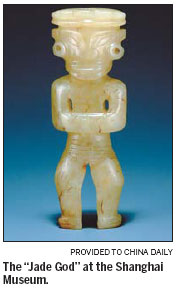Heritage
'Jade God' represents early idea of perfection
Updated: 2011-03-01 07:30
By Zhang Kun (China Daily)
 |
 |
EDITOR's Note: Every week we look at a work of art or a cultural relic that puts the spotlight on China's heritage.
The Shanghai Museum has one of the nation's best collections of antique jade works. Its signature piece is a green jade statue from around 4,000 years ago, unearthed in Tianmen, Hubei province.
Known as the "Jade God", the miniature statue, 10.3 cm high and 3.4 cm wide, depicts a human form standing up, with exaggerated facial characters, in translucent green jade.
It has for several years served as the symbolic image of the Shanghai Museum and featured on many of its publications, while enlarged replicas were made for visitors to the 2010 Shanghai Expo.
It is usually assumed the Jade God was sculpted from the image of the leader or the wizard of a clan.
A ritual object, the worshipped figure wears a flat hat above his square face. Two diamond-shaped lines carve the slanted eyes. He has a broad nose and big mouth, with rings on the ears. The near naked god stands with his legs slightly bent and arms folded. A pierced hole on the statue allows it to be hung from a string or stand on stick.
"Jade statues are quite often found in prehistoric archeology, but most of them are of the human head," writes Shanghai Museum researcher Zhang Wei.
"A whole body form, like this one, is quite rare. The Jade God piece is well crafted, has a beautiful jade texture and is in very good condition - which combined, makes it more precious."
It remains a mystery how jade was carved in prehistoric times, when no metal tools were available. Some hold to an ancient Chinese proverb which goes "stones from other hills may serve to polish jade", and believe harder rocks were used as tools, such as quartz.
Others believe that animal teeth, bones, bamboo and wood were used to sculpt jade. Whichever the case, such a perfect jade statue - with its simple composition, balanced proportion and brilliant quality - gives full display of the high level of craftsmanship during that time.
Chinese were the first people to make use of jade, which is the collective name of several species of translucent to transparent stones. Various jade objects, from 4,000 to 5,000 years old, were unearthed along the Liaohe River in Northeast China, Yellow River in Central and East China, as well as in the Taihu Lake area in the Yangtze Delta.
E-paper

Sindberg leaves lasting legacy
China commemorates Danish hero's courage during Nanjing Massacres.
Crystal Clear
No more tears
Road to the Oscars
Specials

NPC & CPPCC sessions
Lawmakers and political advisers gather in Beijing to discuss major issues.

Sentimental journey
Prince William and Kate Middleton returned to the place where they met and fell in love.

Rent your own island
Zhejiang Province charts plans to lease coastal islands for private investments
